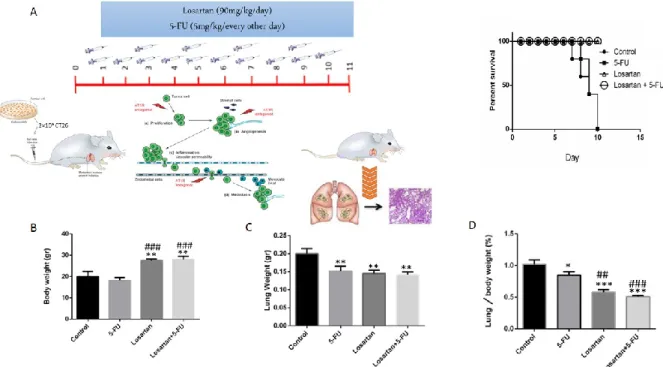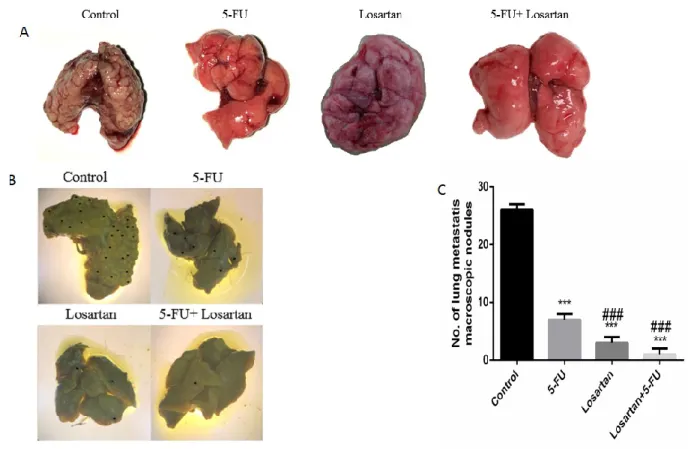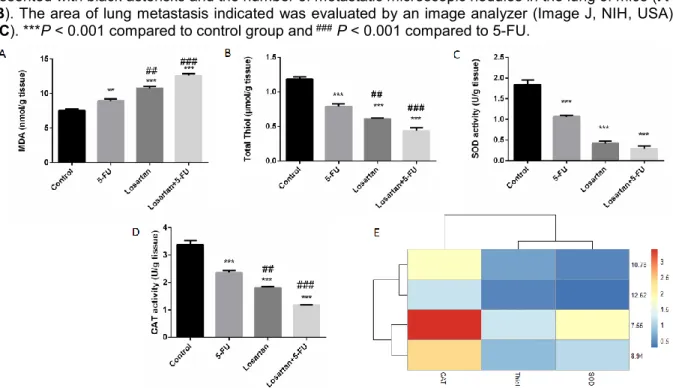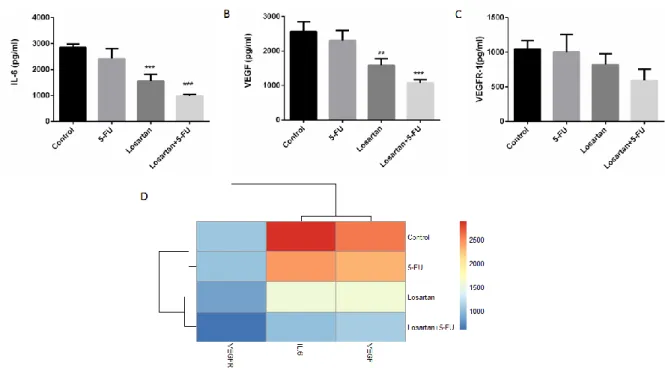Original article:
THE THERAPEUTIC POTENTIAL OF LOSARTAN IN LUNG METASTASIS OF COLORECTAL CANCER
Milad Hashemzehi1,2*, Niloufar Naghibzadeh2*, Fereshteh Asgharzadeh 1,2*, Asma Mostafapour3, Seyed Mahdi Hassanian3, Gordon A. Ferns5, William C. Cho6, Amir Avan2,3,4,#, Majid Khazaei2,3,#
1 Department of Medical Physiology, Faculty of Medicine, Mashhad University of Medical Sciences, Mashhad, Iran
2 Student Research Committee, Faculty of Medicine, Mashhad University of Medical Sciences, Mashhad, Iran
3 Metabolic Syndrome Research Center, Mashhad University of Medical Sciences, Mashhad, Iran
4 Department of Medical Genetics and Molecular Medicine, Faculty of Medicine, Mashhad University of Medical Sciences, Mashhad, Iran
5 Brighton & Sussex Medical School, Division of Medical Education, Falmer, Brighton, Sussex BN1 9PH, UK
6 Department of Clinical Oncology, Queen Elizabeth Hospital, Kowloon, Hong Kong, China
* These authos contributed equally as first author.
# Corresponding authors: Majid Khazaei, MD, Ph.D., and Amir Avan, Ph.D. Metabolic Syndrome Research Center, Mashhad University of Medical Sciences, Mashhad, Iran;
Tel: +98 513 8002298; E-mail: Khazaeim@mums.ac.ir; avana@mums.ac.ir;
http://dx.doi.org/10.17179/excli2020-2093
This is an Open Access article distributed under the terms of the Creative Commons Attribution License (http://creativecommons.org/licenses/by/4.0/).
ABSTRACT
Colorectal cancer (CRC) is a common cancer with a high incidence rate. Components of the renin-angiotensin system (RAS) have been reported to be dysregulated in several malignancies including CRC. Here, we have ex- plored the potential anti-metastatic effects of a RAS inhibitor, losartan, in an experimental model of lung metas- tasis in CRC. A murine model of lung metastasis of CRC was used, which involved the intravenous injection of CT26 cells via a tail vein. Four experimental groups comprised: an untreated group; a group that received 5-FU which was administered intraperitoneally; a losartan group and a combination group that received 5-FU plus losar- tan . We evaluated the anti-inflammatory effects of losartan by histopathological method, and the measurement of oxidative or antioxidant markers including malondialdehyde (MDA) and total thiol (T-SH) tissue levels, superox- ide dismutase (SOD) and catalase activity. We found that losartan inhibited lung metastasis of CRC and there was a reduction of the IL-6 expression level in the tissue sample. It was also associated with reduced levels of the anti- angiogenic factor vascular endothelial growth factor (VEGF). Furthermore, we found that losartan induced oxida- tive stress as assessed by an elevation of MDA level, reduction of T-SH, SOD and catalase activities in lung tissue.
Our findings demonstrated that losartan ameliorates angiogenesis, inflammation and the induction of oxidative stress via angiotensin II type I receptor (AT1R). This may shine some lights on targeting the RAS pathway as a potential therapeutic approach in the treatment of metastatic CRC patients.
Keywords: Renin-angiotensin system, losartan, colorectal cancer, lung metastasis
INTRODUCTION
As one of the most common malignan- cies, colorectal cancer (CRC) constitutes ap- proximately 9 % of all cancers and is the fourth most common cause of cancer-related morbidity and mortality globally (Haggar and Boushey, 2009; Siegel et al., 2017). Colon cancer usually metastasizes to the liver and lung (Mun et al., 2019). Although the pro- gress of CRC screening and surveillance have contributed to the reduction in colon cancer mortality, tumor recurrence and metastasis re- main a common cause of treatment failure.
Therefore, it is important to explore new ther- apies for CRC.
There is growing evidence that compo- nents of the renin-angiotensin system (RAS) are expressed in different types of cancer, in- cluding colon cancer (Godugu et al., 2013).
Not only involved in body fluid homeostasis, this system also has been reported to regulate tumor progression (Wang et al. 2008; Ager et al., 2008). Angiotensin converting enzyme (ACE) is an important component of this sys- tem, and is involved in the production of an- giotensin II (Smith and Missailidis, 2004).
Angiotensin II is a key factor in the renin-an- giotensin system that also gears with cell pro- liferation, angiogenesis and migration of tu- mor cell through the activation of angiotensin type-1 receptor (AT-1) (Neo et al., 2007;
Uemura et al., 2003). Some studies showed that the use of renin-angiotensin system inhib- itors (RASIs) can reduce tumor development in several cancer types (Deshayes and Nahmias, 2005). Previous studies have demonstrated that ACE and ARB reduce liver metastasis from colon cancer by reducing tu- mor growth, angiogenesis yet induce apopto- sis of cancer cells (Neo et al., 2007; Koh et al., 2014). Interestingly, it has also been shown that these drugs can reduce the risk of cancer incidence and improve outcomes in cancer patients (Mc Menamin et al., 2012). In this study, we have evaluated the effects of losartan, as an angiotensin receptor blocker, on lung metastasis of CRC in an experimental animal model.
MATERIAL AND METHODS Reagents and chemicals
5-fluorouracil (5-FU), hematoxylin-eosin (H&E), losartan, and superoxide dismutase (SOD), total thiol (T-SH), catalase (CAT) and malondialdehyde (MDA) assays were pur- chased from Sigma–Aldrich Chemical Co. (St Louis, MO, USA). Streptomycin (50 μg/mL), penicillin (50 IU/mL), fetal bovine serum (FBS) and Dulbecco modified Eagle medium (DMEM) were purchased from Gibco (Gaithersburg, MD, USA). 5-FU and losartan were dissolved in normal saline and distilled water, respectively.
In vitro model
The CT‐26 cell line was purchased from Pasteur Institute, Tehran, Iran. It wasgrown in DMEM supplemented with heat-inacti- vated FBS (10 %) and streptomycin/penicillin (1 %). The cells were incubated at 37 °C with 5 % CO2.
In vivo model
Twenty-four male inbred BALB/c mice (6–8 weeks old / 20-25 g) were purchased from the Pasteur Institute (Tehran, Iran). The animals were kept under standard conditions which were approved by the Institute Animal Ethics Committee of the Mashhad University of Medical Sciences (humidity of 54 ± 2 %, temperature 22 ± 2 °C and 12 h light/dark cy- cle). Mice were injected with 2x10⁶ CT26 cells by intravenous tail injection and were then treated from 24 hours after the cell injec- tion for 10 days (Li et al., 2017). The animals were randomly divided into four groups as follows (n = 6 in each group): 1) a control group, 2) a 5-FU only group (treated with 5 mg/kg every other day, intraperitoneally (ip)) (Marjaneh et al., 2018), 3) a losartan group (treated with 90 mg/kg/day, ip), 4) a combination group (treated with 5mg/kg 5- FU every other day, ip and losartan 90 mg/kg/day, ip). Finally, the animals were sac- rificed and the lungs were removed. The lung tissues were weighed, a part of the tissue was fixed for histological evaluation and another
part was put into Bouin's solutionfor evalua- tion ofappearance symptoms. The rest of the lung was stored at -70 °C for the examination of oxidant, antioxidant agents and inflamma- tory cytokines.
Histological evaluation
The lung tissue was removed and washed with physiological salineand a portion of that was fixed in 10 % formalin. Tissue samples were embedded in paraffin, after dehydration, 5 μm thick sections were cut using a micro- tome. H&E stained sections were examined under light microscopy (×40 magnification).
Evaluation of the metastatic microscopic nodules in the lung
The isolated lung tissue was placed into Bouin's solution, the metastatic nodules were examined using a stereomicroscope. The number of metastatic microscopic nodules in different groups in the lung of mice was eval- uated.
Evaluation of oxidant and antioxidant agents
The fresh lung tissue was stored at -80 °C, and 50 mg of tissue was homogenized in PBS (pH 7.4), then, the homogenized solution was centrifuged for 10 mins and the total thiol group, CAT, SOD, and MDA were measured.
Evaluation of MDA
MDA concentrations were measured as a lipid peroxidation biomarker in lung tissue. 2 mL of thiobarbituric acid solution (TBA) was added to 1 mL of a color with absorption at
max= 535 nm (10 % solution of homoge- nized lung tissue solution. The solution was incubated for 45 mins in a boiling water-bath, then it was centrifuged. MDA reacts with TBA and generates Janero, 1990).
Measurement of total thiol groups
DTNB reagent was used to measure thiol groups. This reagent reacted with the SH groups and it would produce a yellow com- plex (nitro-mercapto benzoate anion), that had an absorption at max= 412 nm (Sadegh- nia et al., 2013). The total thiol content was
measured in tissue based on Ellman method using the following formula: The rate of thiol groups = (A2-A1-B) × (1.07.05)/ 13.6
Measurement of SOD
The measurement is consisted of SOD generation through pyrogallol autoxidation and inhibition of MTT superoxide-dependent revival to formazan. The reaction was stopped by the addition of dimethyl sulfoxide (DMSO), which helps to dissolve formazan and produce a stable color.Overall, the appro- priate amount of homogenized tissue, pyro- gallol, and MTT was appended into the wells and kept for 5 mins at 37 ° C in the dark. After that, it was quenched using DMSO, and anal- ysis was performed at max= 630 nm (refer- ence) and 570 nm (Madesh and Balasubrama- nian, 1998).
Measurement of CAT enzyme activity
The activity of the CAT in tissue was measured by the Aebi method at the absorp- tion spectrum of max= 240 nm. Based on this protocol, we used hydrogen peroxide (30 mM) and phosphate buffer (50 mM). The re- action began with the addition of hydrogen peroxide and the change in absorbance was measured by spectrophotometer for 1 min at
max= 240 nm (Aebi, 1984).
ELISA
Measurements of VEGF/VEGFR-1, IL-6 in lung tissue were performed using Zellbio ELISA kits (ZellBio GmbH, Berlin, Ger- many) according to the manufacturer's in- struction.
In silico and heat map analysis of losartan response signature
We applied Autodock and LigPlot+ soft- ware or R software to evaluate the association of losartan with oxidant/antioxidant factors, IL-6, and VEGF/VEGFR1 markers.
Statistical analysis
All data are shown as mean ± SEM and analyzed by one way ANOVA test followed by LSD as the post hoc test. The data were
calculated using SPSS v.20 statistical soft- ware (IBM, Chicago, IL, USA). The statisti- cal difference was significant at P < 0.05.
RESULTS
Effect of losartan on survival, body weight and lung weight
Losartan alone and losartan plus 5-FU treatment groups increased the survival of the treated animals compared to the control and 5-FU groups (Figure 1A). We also assessed body weight at the end of the experiment. We observed a slightly decreased body weight in the 5-FU group, but it was not statistically sig- nificant. On the contrary, the body weights of the losartan and losartan+5-FU treated groups were significantly greater than those of the untreated group (P < 0.01) and the 5-FU group (P < 0.001) (Figure 1B). Furthermore, there was a significant reduction of lung weight in the 5-FU, losartan, and losartan+5- FU groups compared to the control group (P
< 0.01), but in the losartan and combination group, compared with the 5-FU only group, there was no statistically significant differ-
ence (Figure 1C). In comparison to the con- trols, the percentage of the lung to body weight was lower in the 5-FU group (P <
0.05), as well as losartan and combination groups (P < 0.001 for both). This proportion in losartan and losartan+5-FU treated groups was statistically reduced compared with the 5- FU group (P < 0.01, P < 0.001 respectively) (Figure 1D).
Histological and macroscopic assessment Intravenous injection of CT26 cells into mice led to the development of metastatic nodules in the lung tissue, but after treatment with 5-FU, losartan and the combination of losartan with 5-FU, metastatic nodules were significantly reduced (P < 0.001). Losartan and losartan+5-FU treatment reduced the number of metastatic nodules in lung tissue compared to the treatment with 5-FU (P <
0.001) (Figure 2A-C). Histological images show the number of microscopic nodules and percentage of metastatic area. These results showedthat there was a significant decrease of microscopic nodules in 5-FU, losartan and co-administration of losartan with 5-FU treated
Figure 1: The treatment plan and survival rate of mice (A), Body weight (gr) (B), Lung weight (gr) (C), Lung to body weight ratio ( %) (D). Data are shown as mean ± SEM (n = 6 per group). * P < 0.05, ** P
< 0.01 and *** P < 0.001 compared with control group, ## P < 0.01 and ### P < 0.001 compared with 5-FU group.
Figure 2: The number of macroscopic metastatic lung nodules (A-C). ***P < 0.001 compared to control group and ### P < 0.001 compared to 5-FU.
groups, compared to control (P < 0.001). The number of microscopic nodules was signifi- cantly lower in losartan and losartan+5-FU groups compared to the 5-FU group( P <
0.001) (Figure 3A and B). Furthermore, his- tological evaluation also showed that 5-FU, losartan and losartan+5-FU reduced the per- centage of metastatic area in tissue samples, compared to control group (P < 0.001). We also observed that percentage of metastatic area was reduced in losartan and losartan+5- FU treated groups compared to the 5-FU group (P < 0.001) (Figure 3C).
Oxidative and antioxidative parameters in lung tissue
Statistically, we found that losartan and its combination with 5-FU increased MDA con- centration, compared to the 5-FU treated group (P < 0.01 and P < 0.001, respectively) (Figure 4A). The level of MDA in the 5-FU group was higher than the control group (P <
0.01). The levels of SOD and CAT activities were significantly lower in all treated groups compared to the control group (P < 0.001 both of groups) (Figure 4C-E). CAT activity levels in the losartan and combination of losartan with 5-FU groups were significantly lower compared to the 5-FU group (P < 0.01 and P
< 0.001, respectively). Furthermore, the total thiol content in all the treated groups was sig- nificantly lower than in the untreated group (P
< 0.001 both groups). It has also been shown that total thiol content was significantly de- creased in losartan and its combination with 5-FU than the 5-FU group (P < 0.01 and P <
0.001, respectively) (Figure 4B and E).
IL-6, VEGF and VEGFR-1 levels
The level of tissue IL-6 in the losartan and losartan+5-FU treated groups was signifi- cantly lower than the control group (P <
0.001), but IL-6 level in losartan and its com- bination with 5-FU treated groups was not
Figure 3: H&E staining demonstrated microscopic finding metastatic lung and foci in lung that are rep- resented with black asterisks and the number of metastatic microscopic nodules in the lung of mice (A- B). The area of lung metastasis indicated was evaluated by an image analyzer (Image J, NIH, USA) (C). ***P < 0.001 compared to control group and ### P < 0.001 compared to 5-FU.
Figure 4: The MDA concentrations (A), SOD activity (B), CAT activity (C), total thiol contents (D) asso- ciation between losartan and oxidant/anti-oxidant markers in tissue (E). Data are shown as mean ± SEM (n = 6 per group). ** P < 0.01 and *** P < 0.001 compared with control group, ## P < 0.01 and ### P <
0.001 compared with 5-FU group.
significantly different compared to 5-FU treated group (Figure 5A and D). As shown in Figure 5B-D, the levels of VEGF in the losar- tan group and the group treated with the com- bination of losartan and 5-FU were signifi- cantly lower compared to the control group (P
< 0.01, P < 0.001 respectively). The VEGFR- 1 level of all treated groups was not signifi- cantly different, compared to the control.
DISCUSSION
To the best of our knowledge, this is the first study showing the anti-metastatic poten- tial of losartan in CRC, yet in which lung me- tastasis is widely being reported (Chambers et al., 2002; Neo et al., 2010). It is well known that angiogenesis is crucial in cancer progres- sion and is involved in the development of primary tumor, migration of tumor cells and distant metastasis (Harlozinska, 2005). The ATII/AT1R pathway induces the formation of the new vessels. ATII activated MAPK and
then increased VEGF expression (Fujita et al., 2002). Previous studies have shown that RA- SIs reduced cancer cell metastasis by inhibit- ing angiogenesis through reduction of VEGF expression (Koh et al., 2014; Miyajima et al., 2002). Consistent with these results, we have demonstrated that losartan decreased angio- genesis through the reduction of VEGF level.
ROS production is related to a reduction of cell viability. It also induces cell apoptosis (Ahmadian et al., 2017; Eftekhari et al., 2018). Piskounova et al. demonstrated that oxidative stress suppressed metastasis of can- cer cells (Piskounova et al., 2015). In line with these results, Ahmadian et al. showed that Azilsartan, a novel blocker of AT1R, in- duced ROS formation and then activated apoptotic pathway (Ahmadian et al., 2018).
Interestingly, our results demonstrate that in- hibitory effect of losartan on cancer cells me- tastasis correlates with oxidant/antioxidant status in tumor tissue.
Figure 5: IL-6 level (A), VEGF level (B), VEGFR-1 level (C) and association between losartan and IL- 6, VEGF and VEGFR-1 levels (D). Data are shown as mean ± SEM (n = 6 per group). ** P < 0.01 and
*** P < 0.001 compared to control group.
There is some evidence that activation of AT1R in the tumor microenvironment is in- volved in progression of inflammation and metastasis (Deshayes and Nahmias, 2005).
ATII also enhances the expression of inflam- matory cytokines such as IL-6 by activating AT1R (Suzuki et al., 2003). Furthermore, Coulson et al. also demonstrated losartan could reduce tumor progression via down- regulation of inflammatory cytokine such as IL-6 (Coulson et al., 2017). In addition, Sanchez et al. have shown that losartan de- creases inflammation through reduction of IL-1/-6 and TNF-α levels in LPS-induced in- flammation (Sánchez-Lemus et al., 2009). For us, our results also demonstrated that losartan reduced IL-6 levels in tissue samples, com- pared to the control group.
In conclusion, our data has shown that losartan might reduce lung metastasis via down-regulation of angiogenic and inflam- matory pathways in CRC; however, further extensive clinical studies may be warranted.
Funding
This study was supported by grants awarded by National Institute for Medical Re- search Development, Grant No. 976853 (Majid Khazaei).
Disclosure
The authors have no conflicts of interest to declare.
REFERENCES
Aebi H. Catalase in vitro. Methods Enzymol. 1984;
105:121-6.
Ager EI, Neo J, Christophi C. The renin-angiotensin system and malignancy. Carcinogenesis. 2008;29:
1675-84.
Ahmadian E, Eftekhari A, Fard JK, Babaei H, Nayebi AM, Mohammadnejad D, et al. In vitro and in vivo evaluation of the mechanisms of citalopram-induced hepatotoxicity. Arch Pharm Res. 2017;40:1296-313.
Ahmadian E, Khosroushahi AY, Eftekhari A, Farajnia S, Babaei H, Eghbal MA. Novel angiotensin receptor blocker, azilsartan induces oxidative stress and NFkB- mediated apoptosis in hepatocellular carcinoma cell line HepG2. Biomed Pharmacother. 2018;99:939-46.
Chambers AF, Groom AC, MacDonald IC. Dissemina- tion and growth of cancer cells in metastatic sites. Nat Rev Cancer. 2002;2:563-72.
Coulson R, Liew SH, Connelly AA, Yee NS, Deb S, Kumar B, et al. The angiotensin receptor blocker, Losartan, inhibits mammary tumor development and progression to invasive carcinoma. Oncotarget. 2017;
8:18640-56.
Deshayes F, Nahmias C. Angiotensin receptors: a new role in cancer? Trends Endocrinol Metab. 2005;16:
293-9.
Eftekhari A, Ahmadian E, Panahi-Azar V, Hosseini H, Tabibiazar M, Maleki Dizaj S. Hepatoprotective and free radical scavenging actions of quercetin nanoparti- cles on aflatoxin B1-induced liver damage: in vitro/in vivo studies. Artif Cells Nanomed Biotechnol.
2018;46:411-20.
Fujita M, Hayashi I, Yamashina S, Itoman M, Majima M. Blockade of angiotensin AT1a receptor signaling reduces tumor growth, angiogenesis, and metastasis.
Biochem Biophys Res Commun. 2002;294:441-7.
Godugu C, Patel AR, Doddapaneni R, Marepally S, Jackson T, Singh M. Inhalation delivery of Telmisartan enhances intratumoral distribution of nanoparticles in lung cancer models. J Control Release. 2013;172:86- 95.
Haggar FA, Boushey RP. Colorectal cancer epidemiol- ogy: incidence, mortality, survival, and risk factors.
Clin Colon Rectal Surg. 2009;22:191-7.
Harlozinska A. Progress in molecular mechanisms of tumor metastasis and angiogenesis. Anticancer Res.
2005;25:3327-33.
Janero DR. Malondialdehyde and thiobarbituric acid- reactivity as diagnostic indices of lipid peroxidation and peroxidative tissue injury. Free Radic Biol Med.
1990;9:515-40.
Koh SL, Ager EI, Costa PL, Malcontenti-Wilson C, Muralidharan V, Christophi C. Blockade of the renin- angiotensin system inhibits growth of colorectal cancer liver metastases in the regenerating liver. Clin Exp Me- tastasis. 2014;31:395-405.
Li Y, Wang C, Li D, Deng P, Shao X, Hu J, et al. 1H- NMR-based metabolic profiling of a colorectal cancer CT-26 lung metastasis model in mice. Oncol Rep.
2017;38:3044-54.
Madesh M, Balasubramanian KA. Microtiter plate as- say for superoxide dismutase using MTT reduction by superoxide. Indian J Biochem Biophys. 1998;35: 184- 8.
Marjaneh RM, Rahmani F, Hassanian SM, Rezaei N, Hashemzehi M, Bahrami A, et al. Phytosomal curcu- min inhibits tumor growth in colitis-associated colo- rectal cancer. J Cell Physiol. 2018;233:6785-98.
Mc Menamin ÚC, Murray LJ, Cantwell MM, Hughes CM. Angiotensin-converting enzyme inhibitors and angiotensin receptor blockers in cancer progression and survival: a systematic review. Cancer Causes Con- trol. 2012;23:221-30.
Miyajima A, Kosaka T, Asano T, Asano T, Seta K, Ka- wai T, et al. Angiotensin II type I antagonist prevents pulmonary metastasis of murine renal cancer by inhib- iting tumor angiogenesis. Cancer Res. 2002; 62:4176- 9.
Mun JG, Kee JY, Han YH, Lee S, Park SH, Jeon HD, et al. Galla Rhois water extract inhibits lung metastasis by inducing AMPK‑mediated apoptosis and suppress- ing metastatic properties of colorectal cancer cells. On- col Rep. 2019;41:202-12.
Neo JH, Malcontenti-Wilson C, Muralidharan V, Christophi C. Effect of ACE inhibitors and angiotensin II receptor antagonists in a mouse model of colorectal cancer liver metastases. J Gastroenterol Hepatol. 2007;
22:577-84.
Neo JH, Ager EI, Angus PW, Zhu J, Herath CB, Chris- tophi C. Changes in the renin angiotensin system dur- ing the development of colorectal cancer liver metasta- ses. BMC Cancer. 2010;10:134.
Piskounova E, Agathocleous M, Murphy MM, Hu Z, Huddlestun SE, Zhao Z, et al. Oxidative stress inhibits distant metastasis by human melanoma cells. Nature.
2015;527:186-91.
Sadeghnia HR, Kamkar M, Assadpour E, Boroushaki MT, Ghorbani A. Protective effect of safranal, a con- stituent of crocus sativus, on quinolinic acid-induced oxidative damage in rat hippocampus. Iran J Basic Med Sci. 2013;16:73-82.
Sánchez-Lemus E, Benicky J, Pavel J, Larrayoz IM, Zhou J, Baliova M, et al. Angiotensin II AT1 blockade reduces the lipopolysaccharide-induced innate immune response in rat spleen. Am J Physiol Regul Integr Comp Physiol. 2009;296:1376-84.
Siegel RL, Miller KD, Fedewa SA, Ahnen DJ, Meester RGS, Barzi A, et al. Colorectal cancer statistics, 2017.
CA Cancer J Clin. 2017;67:177-93.
Smith GR, Missailidis S. Cancer, inflammation and the AT1 and AT2 receptors. J Inflamm (Lond). 2004;1:3.
Suzuki Y, Ruiz-Ortega M, Lorenzo O, Ruperez M, Esteban V, Egido J. Inflammation and angiotensin II.
Int J Biochem Cell Biol. 2003;35:881-900.
Uemura H, Ishiguro H, Nakaigawa N, Nagashima Y, Miyoshi Y, Fujinami K, et al. Angiotensin II receptor blocker shows antiproliferative activity in prostate can- cer cells: a possibility of tyrosine kinase inhibitor of growth factor. Mol Cancer Ther. 2003;2:1139-47.
Wang L, Cai SR, Zhang CH, He YL, Zhan WH, Wu H, et al. Effects of angiotensin-converting enzyme inhibi- tors and angiotensin II type 1 receptor blockers on lym- phangiogenesis of gastric cancer in a nude mouse model. Chin Med J (Engl). 2008;121:2167-71.



